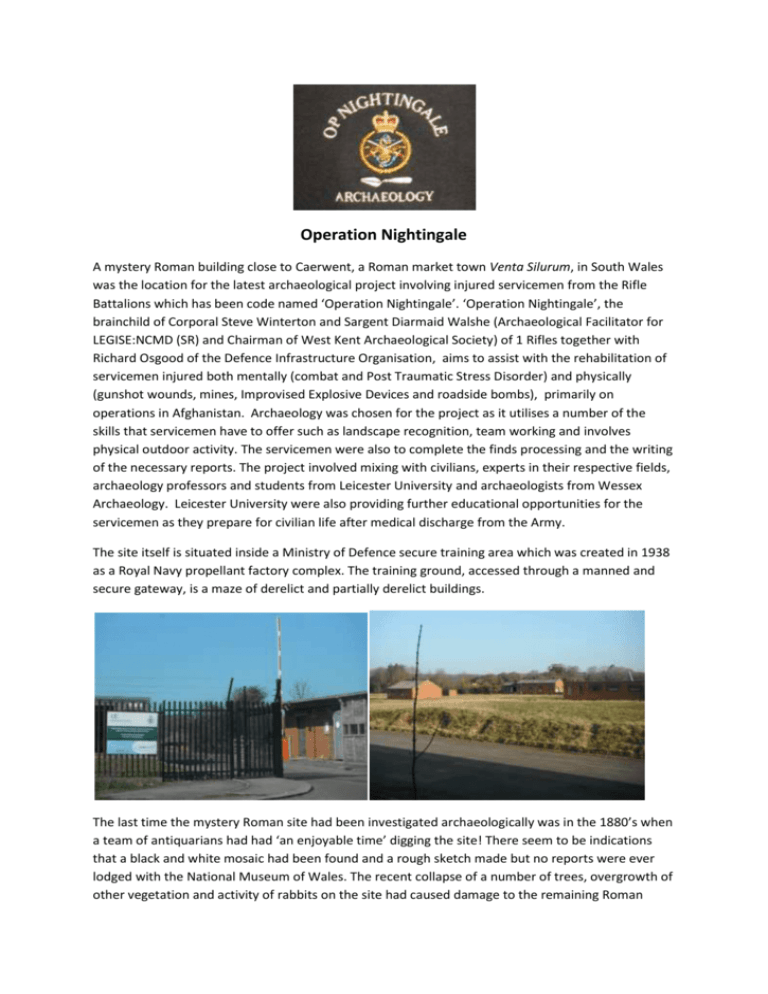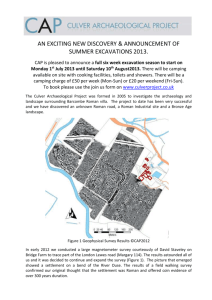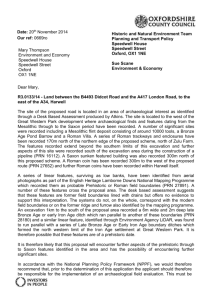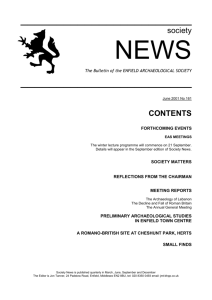Operation Nightingale - West Kent Detector Club
advertisement

Operation Nightingale A mystery Roman building close to Caerwent, a Roman market town Venta Silurum, in South Wales was the location for the latest archaeological project involving injured servicemen from the Rifle Battalions which has been code named ‘Operation Nightingale’. ‘Operation Nightingale’, the brainchild of Corporal Steve Winterton and Sargent Diarmaid Walshe (Archaeological Facilitator for LEGISE:NCMD (SR) and Chairman of West Kent Archaeological Society) of 1 Rifles together with Richard Osgood of the Defence Infrastructure Organisation, aims to assist with the rehabilitation of servicemen injured both mentally (combat and Post Traumatic Stress Disorder) and physically (gunshot wounds, mines, Improvised Explosive Devices and roadside bombs), primarily on operations in Afghanistan. Archaeology was chosen for the project as it utilises a number of the skills that servicemen have to offer such as landscape recognition, team working and involves physical outdoor activity. The servicemen were also to complete the finds processing and the writing of the necessary reports. The project involved mixing with civilians, experts in their respective fields, archaeology professors and students from Leicester University and archaeologists from Wessex Archaeology. Leicester University were also providing further educational opportunities for the servicemen as they prepare for civilian life after medical discharge from the Army. The site itself is situated inside a Ministry of Defence secure training area which was created in 1938 as a Royal Navy propellant factory complex. The training ground, accessed through a manned and secure gateway, is a maze of derelict and partially derelict buildings. The last time the mystery Roman site had been investigated archaeologically was in the 1880’s when a team of antiquarians had had ‘an enjoyable time’ digging the site! There seem to be indications that a black and white mosaic had been found and a rough sketch made but no reports were ever lodged with the National Museum of Wales. The recent collapse of a number of trees, overgrowth of other vegetation and activity of rabbits on the site had caused damage to the remaining Roman structures. This situation had initiated the project which commenced with undergrowth clearance, geophysical survey and inspection of the site by Cadw (Welsh Heritage) representatives. We were lucky enough to be asked to assist, as the metal detecting team, with the ‘Operation Nightingale’ MARS 2 project and travelled to South Wales for a week long excavation of the scheduled ancient monument, with the necessary permissions already in place from Cadw. The excavation team was lead by the Ministry of Defence’s own archaeology professional, Martin Brown, who directed the dig. After introductions, a briefing where we were warned not to venture too far from the excavation site, as we might be kidnapped and interrogated by soldiers who were around the area taking part in a training exercise, and a site visit the operation commenced! Trenches were dug in various areas of the site, primarily over wall remains that had been exposed by fallen trees, in trenches identified as having been dug by the antiquarians, at an area adjacent to the site that had been used as a quarry and on a slope where the land was slipping, gradually down hill towards a disused railway line. We were deployed to detect the topsoil at the sites where the trenches were proposed, in the trenches themselves as they progressed to identify metallic objects in situ for archaeological excavation and on the spoil heaps. We were also allowed access to other areas adjacent to the scheduled site where we were permitted to detect and to dig. The weather was kind to us and good progress was made over the first couple of days and further trenches were started. We were joined during the week by senior members of the armed forces involved in the servicemen’s rehabilitation including Commodore Peter Buxton, the Chairman of the Joint Services Archaeological Society, himself a qualified archaeologist, the Padre and Lieutenant Colonel Paul Marks another metal detectorist. All the visitors took an active part with Peter excavating a trench and Paul recovering metal items from the excavations. We were also visited by journalists from Current Archaeology magazine and Phil Harding from ‘Time Team’ and our claim to fame is having detected his spoil heap but not found anything! We also enjoyed some extra-curricular activities involving visits to the pub to mix with the locals in Caerwent, a private tour of the Roman baths in Bath, together with some consumption of the Bath spring water and a trip to watch a televised Premier Division Rugby match. By the end of the week areas of Roman walls had been exposed, a hypercaust system and some small sections of the mosaic discovered together with some high status pottery and painted wall plaster. We had amassed a collection of 18 Roman coins, all except one, from a fairly narrow time band of 270-350AD, a 1907 Edward VII halfpenny and a 1943 George VI three pence but very few artefacts. The only artefacts were many Roman iron roof nails, two parts from probably the same Roman tumbler lock, a tiny piece of a possible Roman brooch, a piece of casting waste and a yet unidentified item. We can only assume that a lot of the larger coins and many of the artefacts either just were not there or had been recovered by the antiquarians. We did, however, collect an impressive array of cartridge cases (.566 and .762 blanks) and other used military projectiles! After returning home, we processed all the metal finds, identifying them, writing individual small finds reports and taking photographs before returning all the objects and paperwork to the site director for inclusion in the official report and the eventual site archive. It was extremely interesting to be involved in this and hopefully future projects and to assist with the rehabilitation of these young heroes. Indeed, during the Caerwent dig, some of the servicemen were able to get a good night’s sleep for the first time in years. We understand that the project is to be expanded from the 1-7 Rifle Battalions to the rest of the Regiment and indeed to the other services. It is also believed that the American military are looking at the project as a successful rehabilitation course for their own injured personnel. We can only hope that the ‘Operation Nightingale’ project continues to evolve over the coming years and that further young servicemen and women, with an interest in archaeology, can be helped in this way. Lesley & Geoff Burr West Kent Detector Club West Kent Archaeological Society LEGISE:NCMD(SR)








